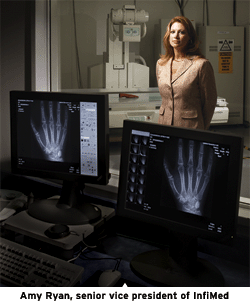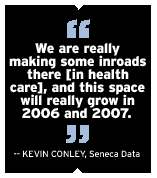Custom Is Critical In The Medical Market
That data often is not going on an expensive array from a brand-name vendor. In fact, if the array is part of a digital medical acquisition system from InfiMed, it was probably built by Seneca Data, North Syracuse, N.Y.

Welcome to the medical industry, where success revolves less around volume than around the ability to design and produce high-quality, customized and stable special-purpose platforms. Little wonder that custom-system builders have consistently cited the health-care market as one of their leading verticals. And that market is likely to grow, said Seneca Data CEO Kevin Conley.
It has only been in the past few years that Seneca Data has started custom-building the systems that run medical devices such as those made by InfiMed, Conley said. Now about one-third of the system builder&s business comes from the medical space, including systems for practice management, emergency rooms and government health departments.
“Medical manufacturers that were building their own proprietary products are moving to off-the-shelf boards,” he said. “They are trying to keep their products priced as competitively as possible. We are making some inroads there, and this space will really grow in 2006 and 2007.”
Custom-system builders can go head-to-head against brand-name commodity server and desktop vendors for general-purpose machines used in a hospital&s nursing stations, patient rooms and accounting departments. But the really successful players in this space are those that can work closely with customers on very specific, highly technical requirements.
Those attributes have formed the basis for a two-year relationship between Seneca Data and InfiMed, a Liverpool, N.Y.-based manufacturer of digital medical acquisition, image processing and sensor solutions, which it sells through OEMs, VARs and distributors to cardiac catherization labs, X-ray departments, imaging centers and trauma centers.
InfiMed historically built its own CPUs, servers and storage subsystems, but working with Seneca Data has enabled the company to focus on its core business of software and specialized hardware development rather than sourcing, said Amy Ryan, senior vice president of InfiMed.
“Seneca Data is close, within a half-hour drive,” she said. “That&s a great value. We can utilize their expertise as an extension to InfiMed&s research group. We have low-volume, high-mix requirements and they have supplier contracts they can leverage.”
That supplier relationship is important to InfiMed, which competes in a highly regulated industry where an upcoming change in regulations means coordinating with suppliers at least six months in advance.
“Our products are mission-critical medical products, and we require significant notice before a change,” she said. “Seneca will keep stock to support our needs and cover us for the time we need to verify the products, notify our customers and get certified. Any change in form, fit or performance of any component or subsystem requires InfiMed to notify our channel partners and, as needed, regulatory agencies.”
The ability to provide clients with stable platforms is also important to Rorke Data, Minneapolis, which integrates Picture Archiving Communications Systems (PACS) used for archiving and distributing bulky medical images such as X-Rays. Rorke custom-builds PACS solutions for some of the top medical equipment vendors, sometimes using Hewlett-Packard servers and sometimes custom-built servers, depending on the application, said Joe Swanson, vice president and general manager at Rorke Data.
But, in general, he said, clients in low-volume situations tend to favor custom servers because of the importance of version control. “There are a limited number of hospitals,” he said. “The market doesn&t justify a large vendor like HP or Dell. We can offer version control—unless there is some component change, in which case we can give the customer a heads-up. And the medical space is very slow to change.”

For those reasons, system builders in this market have to think long term, said Alp Sezen, director of the systems division at Kontron, San Diego, which builds embedded systems for a wide variety of vertical-market applications. Even for unregulated products not attached to patients, clients are loath to make changes less than every five years because it means writing new papers and specifications, he said. For highly regulated patient-attached systems, customers may want to make changes only every seven to 10 years.
Sezen said another important ingredient in serving the market is having a strong engineering team. “Customers& engineers design the products without consideration of the cost,” he said. “Then we look at the cost vs. the design and meet somewhere in the middle. In that phase, we may show the customers how their original idea may work but at the same time waste their resources.”
Working with high-end medical customers requires the system builder to have a strong R&D focus, agreed Jacques Guiloton, western regional vice president of sales at distributor Bell Microproducts, which owns Rorke Data and also builds custom systems for the medical market. “We probably do 70 [percent] to 75 percent of the architecting for the customer,” he said. “Customers know what they need, and they come to us to determine what will fit the bill.”
While price usually is not a prime consideration, it can become more important as medical technology, like so many other technologies, becomes commoditized. “You can now get an MRI in a strip mall for [less than] $500,” Swanson said. “So here, price becomes an issue.”
System builders also are finding opportunities to compete for general workstation business with small form-factor PCs. Kontron, for example, next year expects to sell $30 million worth of an all-in-one workstation designed for hospitals. Sezen said many hospitals have been replacing terminals with PCs, but lack the IT staff to deal with system crashes, unauthorized software downloads and other support issues.
“Hospitals don&t want PCs to look like PCs,” he said. “They want Windows XP because of previous agreements with Microsoft or their server vendors, or they want Explorer to access data, so we sell them fanless systems with no floppy or CD-ROM drives.”
Bold Data Technology, which custom-builds servers and storage arrays for use in medical imaging equipment, also has found success in the hospital market with all-in-one PCs, said Andy Kretzer, director of sales and marketing at the Fremont, Calif.-based company.
Bold Data builds its PCs based on small form-factor PCs from Clevo and Uniwell, two Taiwan-based companies that specialize in mobile PCs. Bold Data&s PCs even include TV tuners, which allow them to be used in patients& rooms as televisions and for surfing the Internet, he said.
As the health-care market continues to update its outmoded technology and invest a variety of new information systems, custom-system builders are likely to maintain an edge in a market that demands special attention.